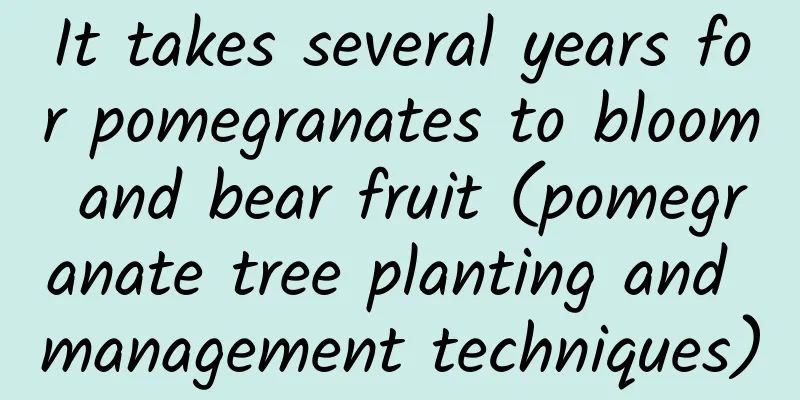It takes several years for pomegranates to bloom and bear fruit (pomegranate tree planting and management techniques)

|
Generally, young pomegranate trees will bear fruit after 4 years, and the peak fruit-bearing period is after 5 years , but the time of fruiting varies due to different planting methods. Pomegranate trees planted with pomegranate seeds will bloom and bear fruit after 6-8 years . Seedlings obtained by high-layering fruiting pomegranate branches will bloom and bear fruit in just 3-4 years . After the pomegranate cuttings survive, it can bloom and bear fruit in the second year. However, in order to have abundant fruit in the future, it is recommended that you can comb the flowers and fruits in the first two years, so that the pomegranate tree is vigorous, and then let it bloom and bear fruit. Two years of vegetative growth can make the pomegranate trunk thicker and the crown fuller. So, how can the pomegranate bloom more? First, lightWhen caring for pomegranates, it is best to place them in a north-facing, south-facing position that provides good ventilation from north to south and sufficient sunlight. For light-loving pomegranates, more light can help them enter the reproductive growth period. On the contrary, in a location with less than 5 hours of light, the pomegranate's branches and leaves have a strong ability to sprout, but the amount of flowers is small. If the pomegranate buds bloom more, then make sure the light reaches more than 6 hours. Second, soilSoil is the key to the root environment of pomegranates. It can coordinate the water, air and fertilizer in the soil. The soil for maintaining pomegranates requires loose and breathable, non-compacted and non-waterlogged, slightly acidic and lightly fertilized soil. It is recommended that you use planting materials. Mix one-third of farmland soil, humus soil and freshwater river sand as planting materials. When planting, you can bury fermented chicken manure and rice husks in the middle and lower layers of the soil. Third, fertilizationIn the first two years of pomegranate growth, fertilizer is generally "nitrogen as the main fertilizer, supplemented by phosphorus and potassium". "Nitrogen" promotes the growth of branches and leaves, and "phosphorus and potassium" promote the growth of the root system, improving the pomegranate's ability to use the environment and resist diseases. It is recommended to apply fertilizer about half a year after planting. It is recommended to apply thin fertilizer frequently, once a month. Bury the "fermented sheep manure balls or chicken manure" in the shallow soil by loosening the soil. When pomegranates are in their adult stage, fertilization can be appropriately biased towards phosphorus and potassium fertilizers. At this time, fertilization changes to "nitrogen as a supplement, phosphorus and potassium as the main". Phosphorus and potassium can effectively promote more flowering of pomegranates. It is recommended to use a 1200 times aqueous solution of "potassium dihydrogen phosphate" to spray the leaves. Do this three times in a row with an interval of one week. After the flowers fade, the pomegranates begin to bear fruit. You can use potassium dihydrogen phosphate again to increase the fruit setting rate . Fourth, pruningPomegranate is a plant with strong germination ability, and any branch that emerges from the soil may sprout. During the growth of pomegranate, bud removal should be carried out from time to time. The base buds and buds that do not need to be retained should be removed in time to reduce the consumption of nutrients and concentrate the nutrients on the retained branches. The branches of pomegranates grow vertically without human intervention and are easily tangled together. During the growth period of pomegranates, we can cut the trunk to remove the top growth advantage and promote the growth of side branches. After the side branches come out, we can pull the branches into oblique growth. Such branches will not block each other's light or hinder ventilation, so there will be more flowering branches and more leaves that can effectively carry out photosynthesis, which will result in more flowers and fruits. |
<<: Can succulent leaf cuttings use germination hormone (how to use succulent germination hormone)
>>: What trees can peppers be grafted on (what rootstocks are used for grafting pepper trees)
Recommend
When do dandelions bloom? What do real dandelions look like?
1. Flowering time Dandelions usually bloom from A...
Can mangoes be grown in Hunan?
Can mangoes be grown in Hunan? Mangoes can be gro...
How to make the Yale Dance so popular
1. Through cuttings If you want to achieve the ef...
When is the best time to plant lettuce?
Lettuce is now widely known to everyone. Whether ...
How to water Anthurium
Anthurium watering method Water quality requireme...
When does the Fire Festival bloom?
Fire Festival Blossom Fire Festival is a succulen...
Can the leaves of Clivia be planted alive? How to plant Clivia to make it live?
1. Can Clivia leaves be planted alive? The leaves...
How often should I change the water for my lucky bamboo?
1. Frequency of water changes 1. Rooting period W...
The sprouted yam, placed in a flowerpot, actually climbed all over the wall and produced yam beans.
Planting Yams with Yam Sticks Step 1 The yam stic...
When is the best time to repot the white palm
Time to repot white palm The growth rate of white...
Time and method of planting northern mustard tuber
Planting time of mustard tuber in the north North...
Planting methods and precautions for Xiashanlan
When to plant Xiashanlan The time to plant mounta...
What vegetables can be grown in December?
As the end of the year approaches, many friends b...
What to do if the stems and leaves of Asparagus turn yellow
Lack of nutrients causes yellowing of stems and l...
What kind of flowerpot is suitable for gardenia?
What kind of flowerpot is suitable for gardenia W...









